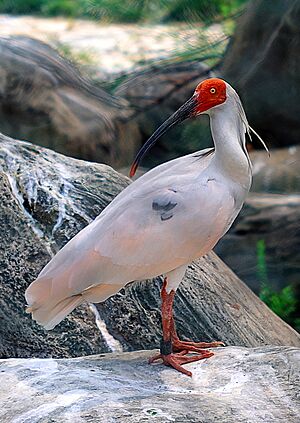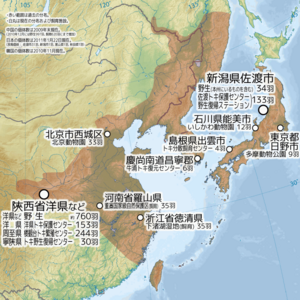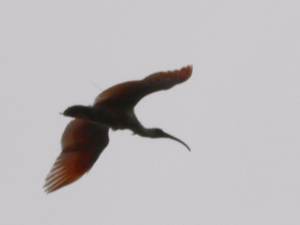Crested ibis facts for kids
Quick facts for kids Crested ibis |
|
|---|---|
 |
|
| Conservation status | |
| Scientific classification | |
 |
|
| former natural range | |
| Synonyms | |
|
The crested ibis (Nipponia nippon) is a special bird. It is also called the Japanese crested ibis or toki. This large bird can be up to 78.5 cm (about 31 inches) long. It has beautiful white feathers. Its head has red skin that you can see. It also has a cool crest of white feathers on the back of its neck. This bird is the only type in its group, Nipponia. It naturally lives in eastern Asia.
Contents
Where Does the Crested Ibis Live?
At one time, the crested ibis lived in many places. These included the Russian Far East, Japan, and Mainland China. It also visited the Korean Peninsula and Taiwan. Sadly, it has disappeared from most of these areas. Today, the only wild population lives in Shaanxi, China.
What Do Crested Ibises Eat?
Crested ibises are not picky eaters. They usually eat insects and frogs. They also enjoy small fish and other tiny animals.
How Do Crested Ibises Build Nests?
These birds build their nests high up in trees. They often choose trees on hills. This way, they can look out over their home.
Saving the Crested Ibis
The crested ibis almost disappeared forever. The last wild one in Japan died in 2003. For a while, people thought they were gone from China too. But then, in 1981, some were found again! These birds were in Shaanxi Province, China.
Many things made them endangered. People hunted too many of them. The use of pesticides hurt them. They also lost their homes due to habitat loss. Their small population size and limited living areas made it worse. Sometimes, they even starved in winter.
To help save them, Japan and China started big programs. They breed these birds in special centers. This helps increase their numbers. The crested ibis is now on China's State Protection List. In 2002, there were 130 groups of these birds in China. A research center in Shaanxi province has helped many chicks hatch. This includes both natural and human-helped hatching.
The crested ibis is also protected by an important agreement called CITES. This agreement helps protect endangered animals around the world.
Bringing Them Back: Reintroductions
Outside of China, only Japan and South Korea have these birds. Both countries are working hard to bring them back into the wild.
Crested Ibis in Japan
On September 25, 2008, something amazing happened in Sado, Niigata, Japan. The Sado Japanese Crested Ibis Preservation Center released 10 birds. This was part of a plan to put 60 ibises back into the wild by 2015. It was the first time these birds had lived freely in Japan since 1981.
Then, on April 23, 2012, three crested ibis chicks hatched on Sado Island. This was a huge success! It was the first time chicks had hatched in the wild in Japan in 36 years.
By June 23, 2022, nearly 500 tokis were living on Sado Island. Their pretty pink feathers and curved beaks now bring tourists to the island. This is a rare success story in saving an endangered bird. It shows how international teamwork and changes in farming can help nature.
Crested Ibis in South Korea
The crested ibis has not been seen in the wild in the Korean Peninsula since 1979. This was near the Korean Demilitarized Zone (DMZ). South Korea is also working to bring them back.
In 2008, China's former President Hu Jintao gave South Korea a pair of these birds. Later, President Xi Jinping gave another pair in 2013. A special center in Changnyeong has bred over 360 crested ibises. The South Korean government has released many of them into the wild. This helps show their efforts to protect different kinds of animals.
See also
- List of Special Places of Scenic Beauty, Special Historic Sites and Special Natural Monuments – the crested ibis is listed



